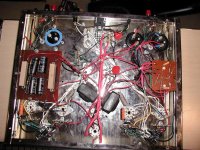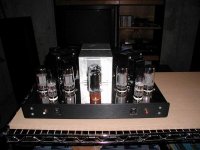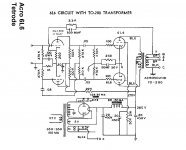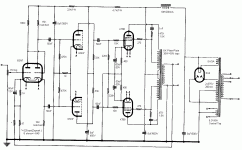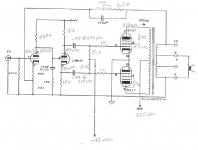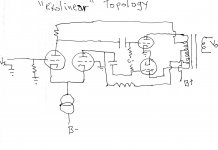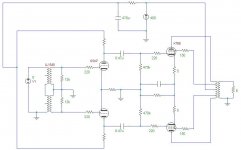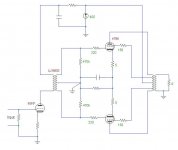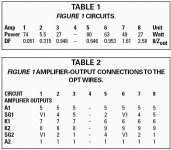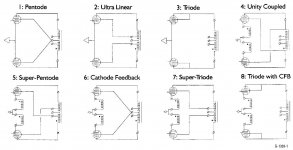Hey all,
Getting ready for my next project. I plan on gutting an existing 6L6GC tube amp I bought years ago since it had some nice components...pics of the amp and internals (yuk) are attached, Generally, here is what major parts I have.
Nice Chassis with Input/Output Transformers installed with 8 Octal Socket holes
Pair of Mil Spec no name Power Transformer 400 0 400, unknown VA but HUGE
Pair 1650N Hammond Trannies
Pair Chokes
Quad Ruby 6L6GC
Quad 6L6
Quad KT88
Quad GE 6550
4 pairs 7N7 (Loctal 6SN7) with sockets
2 Pairs GE and RCA 6SN7
Pair Red base 5691 (6SL7)
pair 1200uf 450V Caps
Plenty 1N4007
2 pairs 5R4 rectifiers
I can use Tube rectifier or SS.
Power Tranny does not have Bias Taps. Don't really want to add another tranny for Bias, so Cathode bias is preferred
I plan on LC filter (choke input)to keep B+ within 450V of my caps
Wanted to do Quicksilver 8417 design, but want to use Octals (already have the holes in Chassis) and don't have bias taps on power tranny
Any recommendations? I have attached a KT88 design and another 6L6 design for starters...
Want to ideally use the amp on my Magnepan Tympani IV's, but may not be possible with a tube amp. Leaning toward a KT88 design due to high-ish power requirements of the maggies...
Getting ready for my next project. I plan on gutting an existing 6L6GC tube amp I bought years ago since it had some nice components...pics of the amp and internals (yuk) are attached, Generally, here is what major parts I have.
Nice Chassis with Input/Output Transformers installed with 8 Octal Socket holes
Pair of Mil Spec no name Power Transformer 400 0 400, unknown VA but HUGE
Pair 1650N Hammond Trannies
Pair Chokes
Quad Ruby 6L6GC
Quad 6L6
Quad KT88
Quad GE 6550
4 pairs 7N7 (Loctal 6SN7) with sockets
2 Pairs GE and RCA 6SN7
Pair Red base 5691 (6SL7)
pair 1200uf 450V Caps
Plenty 1N4007
2 pairs 5R4 rectifiers
I can use Tube rectifier or SS.
Power Tranny does not have Bias Taps. Don't really want to add another tranny for Bias, so Cathode bias is preferred
I plan on LC filter (choke input)to keep B+ within 450V of my caps
Wanted to do Quicksilver 8417 design, but want to use Octals (already have the holes in Chassis) and don't have bias taps on power tranny
Any recommendations? I have attached a KT88 design and another 6L6 design for starters...
Want to ideally use the amp on my Magnepan Tympani IV's, but may not be possible with a tube amp. Leaning toward a KT88 design due to high-ish power requirements of the maggies...
Attachments
The Acro 6l6 version I built something similar many years ago, well the front end was the same but used EL84s as outputs. After many frustrating days I got one channel conditionally stable but gave up as I have enough work to aggravate myself with and one should enjoy hobbies 
Perhaps it needs a special opt for the stability or I just could not do it properly?
The second circuit appears to be the G.E.C. 30W UL design which uses KT66 or KT88 as output tubes, differing with the opt primary and the B+. The KT88 version runs in "almost class A". Never built it. Its a traditional design which should work well.
I don't know how well either of these tube amps would perform with Maggies though there is one way to find out.
Good luck
Perhaps it needs a special opt for the stability or I just could not do it properly?
The second circuit appears to be the G.E.C. 30W UL design which uses KT66 or KT88 as output tubes, differing with the opt primary and the B+. The KT88 version runs in "almost class A". Never built it. Its a traditional design which should work well.
I don't know how well either of these tube amps would perform with Maggies though there is one way to find out.
Good luck
While power hungry, "Maggies" present a tube friendly "flat" impedance curve. 
You will have to squeeze every last Watt out of what you have. Unfortunately, the Hammond O/P "iron" needs some linearizing help from GNFB and you don't have magnetic headroom to spare. You will have to tolerate the shortcomings of the "iron". Since both of the circuits you posted have GNFB loops, they are ruled out.
You will have to tolerate the shortcomings of the "iron". Since both of the circuits you posted have GNFB loops, they are ruled out.
If you SS rectify the B+, you can use "fixed" bias. Phase up the 2 X 5 VAC windings, wire them in series, and voltage multiply the composite.
Phase up the 2 X 5 VAC windings, wire them in series, and voltage multiply the composite.
The filter chokes shown clearly lack the requisite heft for choke I/P service. Also, as the ARRL Handbook states, LCLC is the way to go and you don't have 4 inductors.
The 1N4007 is noisy guano. IMO, that diode should not be in any HIFI equipment, tubed or SS.
IMO, that diode should not be in any HIFI equipment, tubed or SS.
"Fixed" bias and a 450 V. B+ rail should get you to 60 WPC. SS rectification into a CLC filter, where the 1st filter cap. is on the small side, will do the job. Don't forget the CL150 inrush current limiting thermistor.
Since O/P power rules the roost, use full pentode mode "finals" and Maida regulated g2 B+. The "exolinear" topology favored by Doug Piccard (Bandersnatch) gets my nod. You should get the gain you need from a differential cascode made of 7N7 sections, as the triode in that type is reasonably high gm.
Consider rolling the response of the amp off around 28 Hz., at its I/Ps. You are very tight on power O/P and 31 Hz. is the lowest note a double bass produces. IMO, there's no point in trying to handle stuff that can be viewed as infrasonic noise, especially when no spare power is available.
You will have to squeeze every last Watt out of what you have. Unfortunately, the Hammond O/P "iron" needs some linearizing help from GNFB and you don't have magnetic headroom to spare.
If you SS rectify the B+, you can use "fixed" bias.
The filter chokes shown clearly lack the requisite heft for choke I/P service. Also, as the ARRL Handbook states, LCLC is the way to go and you don't have 4 inductors.
The 1N4007 is noisy guano.
"Fixed" bias and a 450 V. B+ rail should get you to 60 WPC. SS rectification into a CLC filter, where the 1st filter cap. is on the small side, will do the job. Don't forget the CL150 inrush current limiting thermistor.
Since O/P power rules the roost, use full pentode mode "finals" and Maida regulated g2 B+. The "exolinear" topology favored by Doug Piccard (Bandersnatch) gets my nod. You should get the gain you need from a differential cascode made of 7N7 sections, as the triode in that type is reasonably high gm.
Consider rolling the response of the amp off around 28 Hz., at its I/Ps. You are very tight on power O/P and 31 Hz. is the lowest note a double bass produces. IMO, there's no point in trying to handle stuff that can be viewed as infrasonic noise, especially when no spare power is available.
Hello Eli,
OK, I can visit PSU designer and make sure I will be at 450V B+ with the CLC (tweak 1st C around 1 - 4uf to get 450V).
What do you recommend on the SS Rectifier if not 1N4007?
Looks like the fixed bias can be made from the 5V (forgot about that). If so I guess I could do the attached (modded Quicksilver 8417 by someone here) - but I don't have the 8417 or the 12BH7...maybe a few tweaks to run a 6550 or KT88 in place of the 8417 and the other half of the 6SL7 for the 12BH7 Phase Splitter?
The QS trannies are 4200 and the 1650N is 4300, close enough?
OK, I can visit PSU designer and make sure I will be at 450V B+ with the CLC (tweak 1st C around 1 - 4uf to get 450V).
What do you recommend on the SS Rectifier if not 1N4007?
Looks like the fixed bias can be made from the 5V (forgot about that). If so I guess I could do the attached (modded Quicksilver 8417 by someone here) - but I don't have the 8417 or the 12BH7...maybe a few tweaks to run a 6550 or KT88 in place of the 8417 and the other half of the 6SL7 for the 12BH7 Phase Splitter?
The QS trannies are 4200 and the 1650N is 4300, close enough?
Attachments
Last edited:
John,
Forget about the 3rd schematic you posted, as it too has a GNFB loop. Your O/P trafos handcuff you, sorry.
The UF4007 and UF5408 are drop in replacements for their 1Nnnnn counterparts. UFnnnn diodes are much quieter than 1N diodes, to begin with, and they are easily snubbed into near complete silence. Schottky diodes are naturally "noiseless", but high PIV Schottkys are costly. Scan the archives for "cockeyed bridge" and you'll find a scheme for employing Schottkys, without going to the poorhouse.
Scan the archives for "exolinear". That topology is a sophisticated form of plate to grid short loop NFB. The O/P trafo is not inside the loop. So, your limited magnetic headroom goes towards music, not an error correction signal. To use GNFB containing topologies, the "iron" needs to be (sic) 100 W. capable.
Forget about the 3rd schematic you posted, as it too has a GNFB loop. Your O/P trafos handcuff you, sorry.
The UF4007 and UF5408 are drop in replacements for their 1Nnnnn counterparts. UFnnnn diodes are much quieter than 1N diodes, to begin with, and they are easily snubbed into near complete silence. Schottky diodes are naturally "noiseless", but high PIV Schottkys are costly. Scan the archives for "cockeyed bridge" and you'll find a scheme for employing Schottkys, without going to the poorhouse.
Scan the archives for "exolinear". That topology is a sophisticated form of plate to grid short loop NFB. The O/P trafo is not inside the loop. So, your limited magnetic headroom goes towards music, not an error correction signal. To use GNFB containing topologies, the "iron" needs to be (sic) 100 W. capable.
Eli,
I have searched EXOLINEAR on here and google and only find references from you to others.
Do you have a simple schematic to give me the gist of what your saying?
If I take the maggies out of the equation, is one of the previous three schematics I posted worth building in your opinion?
One other thing - I was told the following regarding Magnepans from the SS side:
"They have zero phase shift, Maggies, in sharp contrast to other drivers, and this makes them an ideal choice for a global negative feedback amplifier."
Do you not agree? Or may it only be true for SS amps??
I appreciate your assistance....
I have searched EXOLINEAR on here and google and only find references from you to others.
Do you have a simple schematic to give me the gist of what your saying?
If I take the maggies out of the equation, is one of the previous three schematics I posted worth building in your opinion?
One other thing - I was told the following regarding Magnepans from the SS side:
"They have zero phase shift, Maggies, in sharp contrast to other drivers, and this makes them an ideal choice for a global negative feedback amplifier."
Do you not agree? Or may it only be true for SS amps??
I appreciate your assistance....
John,
The speakers are not the problem. The O/P trafos you possess lack the magnetic headroom necessary for GNFB to be employed.
I've uploaded a schematic of "Exolinear" style circuitry. While the drawing is very crude, sloppy, and overly simplistic, it drives the key points home. Notice that the O/P trafo is not inside a NFB loop. If you look carefully, you will see short loop NFB from O/P tube plate to O/P tube grid.
The speakers are not the problem. The O/P trafos you possess lack the magnetic headroom necessary for GNFB to be employed.
I've uploaded a schematic of "Exolinear" style circuitry. While the drawing is very crude, sloppy, and overly simplistic, it drives the key points home. Notice that the O/P trafo is not inside a NFB loop. If you look carefully, you will see short loop NFB from O/P tube plate to O/P tube grid.
Attachments
I've uploaded a schematic of "Exolinear" style circuitry....
Eli, I like your schematic
Eli, I like your schematicWhat are you using for CCS B-?
That drawing is not an actual implementation. In the OP's case, the splitter will be a differential cascode and both negative voltages will come from "taps" on a voltage multiplier energized by 5 VAC windings made spare by SS B+ rectification. The OP has a pair of power trafos.
If you want to get into the nuts and bolts of "Exolinear" style circuitry, contact Doug Piccard, AKA Bandersnatch. Doug has done considerable work with the concept.
Eli,
OK...Its the tranny that's lacking, and not the speakers...
I would like to see more of this design/schematic...looks interesting - OPT UL taps would supply my 7N7 front end plates...what would the benefit here be? Don't you want a stable DC voltage supply here? Wouldn't UL connected voltage swing all over the place with respect to the output?
Oh...sorry, a form of feedback maybe?
Sorry for the lame questions...I'm not as versed as I would like...still a bit of a tyro...
Hey, Hey Bandersnatch, what say you?
BTW -> Is it me or does anyone else think of Squiggy (of Lenny and Squiggy fame) when Bandy enters a thread? Too funny.
OK...Its the tranny that's lacking, and not the speakers...
I would like to see more of this design/schematic...looks interesting - OPT UL taps would supply my 7N7 front end plates...what would the benefit here be? Don't you want a stable DC voltage supply here? Wouldn't UL connected voltage swing all over the place with respect to the output?
Oh...sorry, a form of feedback maybe?
Sorry for the lame questions...I'm not as versed as I would like...still a bit of a tyro...
Hey, Hey Bandersnatch, what say you?
BTW -> Is it me or does anyone else think of Squiggy (of Lenny and Squiggy fame) when Bandy enters a thread? Too funny.
Last edited:
Eli,
OK...Its the tranny that's lacking, and not the speakers...
I would like to see more of this design/schematic...looks interesting - OPT UL taps would supply my 7N7 front end plates...what would the benefit here be? Don't you want a stable DC voltage supply here? Wouldn't UL connected voltage swing all over the place with respect to the output?
Oh...sorry, a form of feedback maybe?
Sorry for the lame questions...I'm not as versed as I would like...still a bit of a tyro...
Hey, Hey Bandersnatch, what say you?
BTW -> Is it me or does anyone else think of Squiggy (of Lenny and Squiggy fame) when Bandy enters a thread? Too funny.
That 60 W. Hammond trafo will work with GNFB in a guitar amp, where deep bass performance is of no consequence. Unfortunately, in HIFI service, the deep bass error correction signal associated with GNFB will saturate the trafo's core. Manure smells better than a trafo whose core is saturating sounds.
Look at the drawing again. Connecting the LTP load resistors to taps on the O/P trafo primary, instead of B+, creates AC paths between the plates of the O/P tubes and their control grids. Voilla, short loop NFB, at the tap %, is present. The CCS in the LTP's tail forces symmetry between the 2 halves.
FWIW, I see 2 ways around cascodes in the LTP. Use 6AC7 pentodes or "front" a routine 7N7 differential gain block with a 5691 SRPP. BTW, the Locktal equivalent of the 6SL7 is the 7F7.
I actually haver a pile of 7N7's and 7F7's in my stash...if I only had a schematic I could start something. I am not smart enough to put a schematic together myself...Although I could try something...
Would an LM317 work for the 7N7 (or 7F7) LTP CCS?
Edit - Whoops, I just saw that B- in your schematic....that voltage is like too high for the LM317
Would an LM317 work for the 7N7 (or 7F7) LTP CCS?
Edit - Whoops, I just saw that B- in your schematic....that voltage is like too high for the LM317
Last edited:
John,
The IXYS 10M45S is "good enough" for the current sink. Cascoded FETs will work better.
A "simple" LTP using 6SL7 class triodes may lack the gain and certainly lacks the "stones" for this job. A "simple" LTP using 6SN7 class triodes has the requisite "cojones", but definitely lacks sufficient gain.
Like it or not, you are in the business of turning a sow's ear into a silk purse. Some poop shoveling on your part is necessary. Choose between pentodes or cascodes in the LTP, in order to have a 2 stage design. A "routine" LTP built around a 7N7 requires an additional gain block.
B- is not ground. It is a negative rail sufficient to operate the CCS and provide compliance with the I/P signal. About 50 V. does the job.
The IXYS 10M45S is "good enough" for the current sink. Cascoded FETs will work better.
A "simple" LTP using 6SL7 class triodes may lack the gain and certainly lacks the "stones" for this job. A "simple" LTP using 6SN7 class triodes has the requisite "cojones", but definitely lacks sufficient gain.
Like it or not, you are in the business of turning a sow's ear into a silk purse. Some poop shoveling on your part is necessary. Choose between pentodes or cascodes in the LTP, in order to have a 2 stage design. A "routine" LTP built around a 7N7 requires an additional gain block.
B- is not ground. It is a negative rail sufficient to operate the CCS and provide compliance with the I/P signal. About 50 V. does the job.
Last edited:
Here are two.
One uses a low-level signal transformer as the input and phase splitter, followed by push-pull drivers and KT88 power tubes. You may not get enough gain with this arrangement, depending on your preamp's voltage output.
The second design uses an interstage transformer fed by single-ended driver. This imparts a "single-ended sound" to your push-pull design. I built one of these using the 6C30pi and Plitron output transformers with cathode feedback taps.
One uses a low-level signal transformer as the input and phase splitter, followed by push-pull drivers and KT88 power tubes. You may not get enough gain with this arrangement, depending on your preamp's voltage output.
The second design uses an interstage transformer fed by single-ended driver. This imparts a "single-ended sound" to your push-pull design. I built one of these using the 6C30pi and Plitron output transformers with cathode feedback taps.
Attachments
... Want to ideally use the amp on my Magnepan Tympani IV's ...
Yes, Eli, I agree wholeheartedly. I didn't pay enough attention to the original post.
I used Plitron cathode feedback transformers for my KT88 design. These are good for 100W output - paralleled KT88 in push-pull would yield a lot of power.
VanDerVeen explored using cathode feedback transformers with a single pair of EL34 in push pull ... 80W with a damping factor of 0.6! This is in the territory for Magnepans.
Undoubtedly, after my own experience with Plitron and VanDerVeen's designs, I can recommend only these transformers for the highly demanding Magnepan application.
John65b should purchase VenDerVeen's book here before making any decisions. Maggies are a big project, requiring big research.
IMHO, I would build a VenDerVeen output stage with two or four KT88 in push-pull using Plitron 4070-CFB or 2100-CFB cathode feedback output transformers. One option would be a single-ended gain stage driving the KT88 grids through a LL1660S interstage transformer. Global feedback can be wrapped around the entire circuit to the driver stage's cathode. I prefer using transformers as the phase splitter, everything seems to work out nicer that way.
Attachments
Maybe best to reconsider designing around the maggies? To much a stretch?
You'll do fine with the "Maggies", as long as you don't play truly demanding material. Concert level reproduction of Liszt, Suppe, and Tchaikovsky "potboilers" done by 100+ players is probably an overreach, but jazz ensembles, chamber music, Mozart, Haydn, and a lot of Beethoven are within grasp.
Most of the available speakers require at least a respectable damping factor. You must use NFB of some kind to get that with pentode mode "finals". Some speakers will be OK with triode mode "finals" and no NFB. Proper mating of amp and speakers is a LARGE part of getting good sound.
Maybe best to reconsider designing around the maggies? To much a stretch?
Heavens, no! We had a pair of Magnepan SMG running on a Harman Kardon Citation II. This amplifier uses two 6550 (similar to KT88) in push pull per channel. We even ran the SMGs with the MC-30, built with two 6550 using McIntosh's unity-gain coupling. The Citation II ran much hotter, and with more authority.
It's a big amp, tho. Makes lots of heat. You'll need to consider your amplifier design carefully, but it's certainly a great project, and you will find lots of help on this forum.
Do some research. Before spending the $$ on tubes and big output transformers (you will need "big"), buy a couple books (aka Vanderveen) and do some reading. Find past issues of AudioXpress, Glass Audio, or Vacuum Tube Valley.
I've already thrown in my two bits, based on my personal experiences with Plitron CFB transformers. For the power and requirements you need, I think they can't be beat.
- Status
- This old topic is closed. If you want to reopen this topic, contact a moderator using the "Report Post" button.
- Home
- Amplifiers
- Tubes / Valves
- Recommend me a KT88/6550 + 7N7 (6SN7) Schematic!
